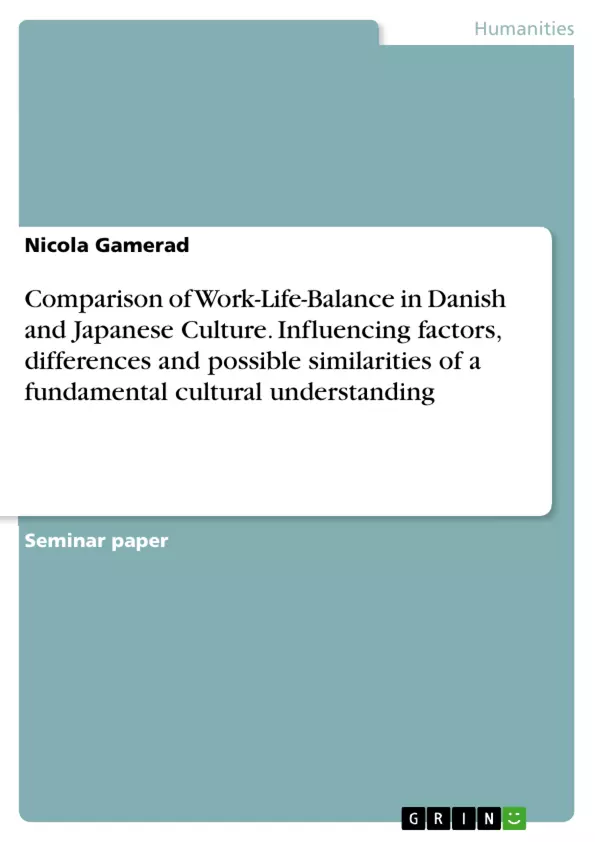Due to technologisation and globalisation, the demographic development and an ever-faster growing global competition, there have been a lot changes of values within working cultures worldwide. Especially modern working world demands on employees are placed in a different light. Long working hours, additional overtime and the need of permanent availability are taking an ever-increasing amount of many employee’s time. The own time management is becoming a balancing act between professional and private life and for employees it is a major challenge to find the right balance.
Based on this, the countries Denmark and Japan are analysed and compared afterwards due to some selected factors of the cultural model of Geert Hofstede in this term paper having special focus on the country-specific Work-Life-Balance and its influencing factors to point out differences and possible similarities of a fundamental cultural understanding. Therefore, chapter two provides a definition of the term Work-Life-Balance (short: WLB) and a theoretical introduction of two dimensions of the cultural theory of Geert Hofstede. Following, the countries Denmark and Japan are analysed individually at first and compared with each other afterwards in chapter four. Finally, the concept of WLB is applied to the cultural comparison to provide possible recommendations for improvements regarding the differences in cultural understandings. Finally, the term paper is rounded off with a conclusion and outlook.
Inhaltsverzeichnis (Table of Contents)
- Introduction
- Theoretical Background
- Definition Work-Life-Balance
- Dimensions of Culture by Geert Hofstede
- Analysis of Culture
- Danish Culture
- Japanese Culture
- Comparison of Danish and Japanese Culture
- Applied Learning: Different Cultures dealing with Work-Life-Balance
- Conclusion and Outlook
Zielsetzung und Themenschwerpunkte (Objectives and Key Themes)
This term paper aims to analyze and compare the cultures of Denmark and Japan, focusing on the concept of Work-Life-Balance (WLB) and its influencing factors. The paper utilizes the cultural model of Geert Hofstede to highlight the differences and possible similarities in cultural understanding between the two countries.
- Definition and understanding of Work-Life-Balance
- Cultural dimensions of Denmark and Japan according to Geert Hofstede's model
- Comparison of cultural practices related to Work-Life-Balance in both countries
- Impact of cultural differences on WLB perceptions and practices
- Recommendations for improving understanding and promoting better WLB in a global context
Zusammenfassung der Kapitel (Chapter Summaries)
- Introduction: This chapter introduces the topic of Work-Life-Balance, emphasizing the changing demands of the modern working world and the need for employees to find a balance between professional and private life. It outlines the paper's objective to analyze and compare Denmark and Japan's cultural perspectives on WLB, utilizing Geert Hofstede's cultural model.
- Theoretical Background: This chapter provides a definition of Work-Life-Balance, exploring its different interpretations and understandings. It also introduces two dimensions of Geert Hofstede's cultural theory: Individualism versus Collectivism (IDV) and Power Distance Index (PDI), which are relevant to the analysis of Danish and Japanese cultures.
- Analysis of Culture: This chapter explores the cultural characteristics of Denmark and Japan, examining aspects related to WLB through the lens of Geert Hofstede's cultural dimensions. It analyzes each country's cultural values, beliefs, and practices that influence the perception and management of work and personal life.
- Comparison of Danish and Japanese Culture: This chapter compares the cultural characteristics of Denmark and Japan based on the previous analysis. It highlights similarities and differences in their cultural values and practices related to WLB, identifying potential areas where cultural understanding might be crucial for achieving better balance in a global context.
- Applied Learning: Different Cultures dealing with Work-Life-Balance: This chapter applies the cultural comparison to real-world scenarios, exploring how different cultural perspectives on WLB impact individual and organizational practices. It provides insights into the challenges and opportunities of navigating cultural differences in a globalized workplace, with a focus on improving understanding and promoting more balanced lifestyles.
Schlüsselwörter (Keywords)
The main keywords and focus topics of this paper are Work-Life-Balance (WLB), cultural analysis, cross-cultural comparison, Geert Hofstede's cultural model, Denmark, Japan, Individualism versus Collectivism (IDV), Power Distance Index (PDI), cultural values, cultural practices, globalized workplace, and cultural understanding.
- Citation du texte
- Nicola Gamerad (Auteur), 2017, Comparison of Work-Life-Balance in Danish and Japanese Culture. Influencing factors, differences and possible similarities of a fundamental cultural understanding, Munich, GRIN Verlag, https://www.grin.com/document/388178



